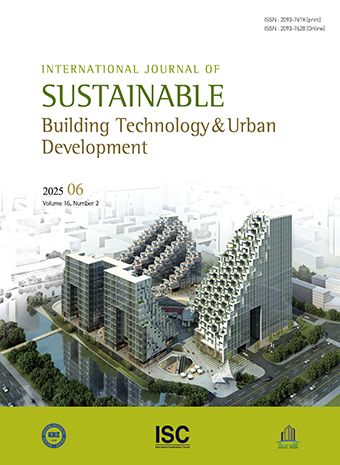General Article
F. Hanim, A.A. Aziz, M. Yuhaniz, and S.S. Ahmad, Covid-19 Pandemic: Strategies to Improve Daylighting and Visual Comfort for Building Occupants, in Advances in Civil Engineering Materials, Springer, 2022, pp. 203-214.
10.1007/978-981-16-8667-2_22R. Sithravel and R. Ibrahim, Identifying supportive daytime lighting characteristics for enhancing individuals' psychophysiological well-being in windowless workplace in tropical Malaysia. Indoor and Built Environment. 30 (2019), pp. 298-312.
10.1177/1420326X19889656R. Hiyasat, M. Sosa, and L. Ahmad, Use of workspace at home under COVID-19 conditions in the UAE. Engineering, Construction and Architectural Management. 30 (2022), pp. 3142-3159.
10.1108/ECAM-10-2021-0857S. Roumi, F. Zhang, R.A. Stewart and M. Santamouris, Commercial building indoor environmental quality models: A critical review. Energy Build. 263 (2022), 112033.
10.1016/j.enbuild.2022.112033J. Morales-Bravo and P. Navarrete-Hernandez, Enlightening well-being in the home: The impact of natural light design on perceived happiness and sadness in residential spaces. Build Environ. 223 (2022), 109317.
10.1016/j.buildenv.2022.109317C.Y.S. Heng, Y.W. Lim, and D.R. Ossen, Horizontal light pipe transporter for deep plan high-rise office daylighting in tropical climate. Build Environ. 171 (2020), 106645.
10.1016/j.buildenv.2020.106645R. Aslanoğlu, J.K. Kazak, S. Yekanialibeiglou, P. Pracki, and B. Ulusoy, An international survey on residential lighting: Analysis of summer-term results. Build Environ. 232 (2023), 109972.
10.1016/j.buildenv.2022.10997236644492PMC9827736T.G. Farea, D.R. Ossen, and A. Isah, Common configuration of light-well in high-rise residential buildings in Kuala Lumpur. 4th International Network for Tropical Architecture (iNTA) (2012), pp. 12-19.
Y.W. Fung and W.L. Lee, Identifying the most influential parameter affecting natural ventilation performance in high-rise high-density residential buildings. Indoor and Built Environment. 24 (2015), pp. 803-812.
10.1177/1420326X14536189S. Omrani, V. Garcia-Hansen, B. Capra, and R. Drogemuller, Natural ventilation in multi-storey buildings: Design process and review of evaluation tools. Build Environ. 116 (2017), pp. 182-194.
10.1016/j.buildenv.2017.02.012S. Mirrahimi, M.F. Mohamed, L.C. Haw, N.L.N. Ibrahim, W.F.M. Yusoff, and A. Aflaki, The effect of building envelope on the thermal comfort and energy saving for high-rise buildings in hot-humid climate. Renewable and Sustainable Energy Reviews. 53 (2016), pp. 1508-1519.
10.1016/j.rser.2015.09.055Y.Y. Lee, M.F. Md Din, K. Iwao, Y.H. Lee, and N. Anting, Impact of thermal behaviour of different environmental conditions on ambient environment and thermal discomfort in Malaysia. Indoor and Built Environment. 30 (2021), pp. 520-534.
10.1177/1420326X19897956N.A. Ibrahim, S.R. Wan Alwi, Z. Abd Manan, A.A. Mustaffa, and K. Kidam, Climate change impact on solar system in Malaysia: Techno-economic analysis. Renewable and Sustainable Energy Reviews. 189 (2024), 113901.
10.1016/j.rser.2023.113901J.A. Engel-Cox, N.L. Nair, and J.L. Ford, Evaluation of solar and meteorological data relevant to solar energy technology performance in Malaysia. Journal of Sustainable Energy & Environment. 3 (2012), pp. 115-124.
N.T.K. Phuong, Luminance distributions in the tropical sky conditions, Magazine of Civil Engineering. (2018), pp. 192-204.
J.K. Day, B. Futrell, R. Cox, S.N. Ruiz, A. Amirazar, A.H. Zarrabi and M. Azarbayjani, Blinded by the light: Occupant perceptions and visual comfort assessments of three dynamic daylight control systems and shading strategies. Build Environ. 154 (2019), pp. 107-121.
10.1016/j.buildenv.2019.02.037K. Konis, A circadian design assist tool to evaluate daylight access in buildings for human biological lighting needs. Solar Energy. 191 (2019), pp. 449-458.
10.1016/j.solener.2019.09.020P. Bakmohammadi and E. Noorzai, Optimization of the design of the primary school classrooms in terms of energy and daylight performance considering occupants' thermal and visual comfort. Energy Reports. 6 (2020), pp. 1590-1607.
10.1016/j.egyr.2020.06.008L. Bergefurt, M. Weijs-Perrée, R. Appel-Meulenbroek, and T. Arentze, The physical office workplace as a resource for mental health-A systematic scoping review. Build Environ. 207 (2022), 108505.
10.1016/j.buildenv.2021.108505M.B.C. Aries, M.P.J. Aarts, and J. van Hoof, Daylight and health: A review of the evidence and consequences for the built environment. Lighting Research & Technology. 47 (2015), pp. 6-27.
10.1177/1477153513509258A. Tabadkani, A. Roetzel, H.X. Li, and A. Tsangrassoulis, Daylight in Buildings and Visual Comfort Evaluation: The Advantages and Limitations. Journal of Daylighting. 8 (2021), pp. 181-203.
10.15627/jd.2021.16E. Sorooshnia, M. Rashidi, P. Rahnamayiezekavat, F. Rezaei, and B. Samali, Optimum external shading system for counterbalancing glare probability and daylight illuminance in Sydney's residential buildings. Engineering, Construction and Architectural Management. 30 (2023), pp. 296-320.
10.1108/ECAM-03-2021-0191L. Lan, K.L. Wood, and C. Yuen, A holistic design approach for residential net-zero energy buildings: A case study in Singapore. Sustain Cities Soc. 50 (2019), 101672.
10.1016/j.scs.2019.101672D. Susanto and G.A.F. Rahayu, Daylight analysis in low-cost apartments in Jakarta, in 2018 2nd International Conference on Smart Grid and Smart Cities (ICSGSC). (2018), pp. 21-25.
10.1109/ICSGSC.2018.8541339T.J. Dabe and V.S. Adane, Evaluation of Daylight Parameters on the Basis Simulation Model For the Tropical Climate. Journal of Architectural Environment & Structural Engineering Research. 3 (2020), pp. 22-28.
10.30564/jaeser.v3i2.598R.S. Priya and K. Kalaimathy, Evaluating daylighting effectiveness of a traditional house in tropical climate. Mater Today Proc. (2022).
J.A. Jakubiec, T. Srisamranrungruang, Z. Kong, G. Quek, and R. Talami, Subjective and Measured Evidence for Residential Lighting Metrics in the Tropics, in Proceedings of Building Simulation 2019: 16Th Conference of Ibpsa. (2019), pp. 1151-1159.
K.A. Mohamed, A. Ismail, and N.A. Ahmad, The effects of internal partition on indoor daylighting performance of student residential building in Ipoh, Perak. Malaysian Journal of Sustainable Environment (MySE). 7 (2020), pp. 1-24.
10.24191/myse.v7i2.10261Y. Suriansyah, The Potential of Natural Daylight Utilization for the Visual Comfort of Occupants in Two Units of Service Apartments Certified as Green Buildings in Kuala Lumpur, Malaysia. International Journal of Integrated Engineering. 12 (2020), pp. 276-289.
N. Jayaweera, U. Rajapaksha, and I. Manthilake, Enhancing the daylight and energy performance of external shading devices in high-rise residential buildings in dense urban tropics. Journal of Green Building. 16 (2021), pp. 87-108.
10.3992/jgb.16.3.87A.-T. Nedhal, F.S.F. Syed and A. Adel, Relationship between window-to-floor area ratio and single-point daylight factor in varied residential rooms in Malaysia. Indian J Sci Technol. 9 (2016), pp. 22-30.
10.17485/ijst/2016/v9i33/86216F. Seraj and M.A.R. Joarder, Effect of Different Balcony Shading Configurations on Daylighting Residential Dining Spaces in Tropical Climate. DUET Journal. 5 (2019), pp. 27-35.
H. Medhat Assem, L. Mohamed Khodeir, and F. Fathy, Designing for human well-being: The integration of neuroarchitecture in design - A systematic review. Ain Shams Engineering Journal. 14 (2023), 102102.
10.1016/j.asej.2022.102102N. Elakkad and W.S.E. Ismaeel, Coupling performance-prescriptive based daylighting principles for office buildings: A case study from Egypt. Ain Shams Engineering Journal. 12 (2021), pp. 3263-3273.
10.1016/j.asej.2020.09.030N. Kumar and R. Bardhan, Optimising Building Fenestration Design for Daylight and Energy Savings in Low-Income Housing: Case of Mumbai, India. in Urban Science and Engineering. (2021), pp. 447-458.
10.1007/978-981-33-4114-2_36S.N.F.S. Husin and Z.Y.H. Harith, The performance of daylight through various windows for residential buildings. Asian Journal of Environment-Behaviour Studies. 3 (2012), pp. 85-96.
J. Zhang and L. Ji, Optimisation and Prediction of Energy Consumption, Daylighting, and Thermal Comfort of Buildings in Tropical Areas. Advances in Civil Engineering. 2022 (2022), pp. 1-14.
10.1155/2022/3178269A. Budhiyanto, A. Oktavianus, B. Tedjokusumo, K. Harsono, and I.T. Yang, Comparison of simulation-based methods and metaheuristic optimisation algorithms for optimising window design by considering daylighting and heat transfer in a tropical region of Indonesia, in IOP Conference Series: Earth and Environmental Science, 907 (2021), 012016.
10.1088/1755-1315/907/1/012016S.M. Mousavi, T.H. Khan, and A. Mohammadi, Adjustable Internal Shading for Home Office Daylighting in Tropical Climates. International Journal of Design and Nature and Ecodynamics. 16 (2021), pp. 609-624.
10.18280/ijdne.160601M. Alwetaishi, H. Al-Khatri, O. Benjeddou, A. Shamseldin, M. Alsehli, S. Alghamdi and R. Shrahily, An investigation of shading devices in a hot region: A case study in a school building. Ain Shams Engineering Journal. 12 (2021), pp. 3229-3239.
10.1016/j.asej.2021.02.008A.A. Salem Bahdad, S.F. Syed Fadzil, H.O. Onubi, and S.A. BenLasod, Balancing daylight in office spaces with respect to the indoor thermal environment through optimisation of light shelves design parameters in the tropics. Indoor and Built Environment. 31 (2022), pp. 1963-1985.
10.1177/1420326X221086537A.A.E.-M.M. Ali Ahmed, Using simulation for studying the influence of vertical shading devices on the thermal performance of residential buildings (Case study: New Assiut City). Ain Shams Engineering Journal. 3 (2012), pp. 163-174.
10.1016/j.asej.2012.02.001Department of Standards Malaysia, MS 2680: 2017 Malaysian Standard - Energy Efficiency and Use of Renewable Energy for Residential Buildings - Code of Practice, 2017.
Department of Standards Malaysia, MS 1525: 2019 Energy Efficiency and Use of Renewable Energy for Non-Residential Buildings-Code of Practice (Third Version), 2019.
D.H.W. Li, S. Li, W. Chen, and S. Lou, Simple correlations between point daylight factor, average daylight factor and vertical daylight factor under all sky conditions and building design implications. Indoor and Built Environment. 31 (2022), pp. 1700-1714.
10.1177/1420326X211061111N.D. Dahlan, P.J. Jones, D.K. Alexander, E. Salleh, and J. Alias, Daylight ratio, luminance, and visual comfort assessments in typical Malaysian hostels. Indoor and Built Environment. 18 (2009), pp. 319-335.
10.1177/1420326X09337041Y.W. Lim, M.Z. Kandar, M.H. Ahmad, D.R. Ossen, and A.M. Abdullah, Building façade design for daylighting quality in typical government office building. Build Environ. 57 (2012), pp. 194-204.
10.1016/j.buildenv.2012.04.015I. Dianat, A. Sedghi, J. Bagherzade, M.A. Jafarabadi, and A.W. Stedmon, Objective and subjective assessments of lighting in a hospital setting: implications for health, safety and performance. Ergonomics. 56 (2013), pp. 1535-1545.
10.1080/00140139.2013.82084523879884- Publisher :Sustainable Building Research Center (ERC) Innovative Durable Building and Infrastructure Research Center
- Publisher(Ko) :건설구조물 내구성혁신 연구센터
- Journal Title :International Journal of Sustainable Building Technology and Urban Development
- Volume : 15
- No :2
- Pages :140-159
- Received Date : 2024-01-12
- Accepted Date : 2024-06-21
- DOI :https://doi.org/10.22712/susb.20240012




 International Journal of Sustainable Building Technology and Urban Development
International Journal of Sustainable Building Technology and Urban Development










